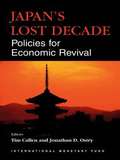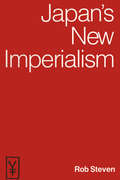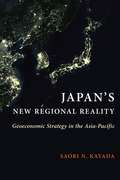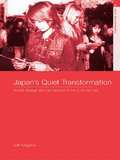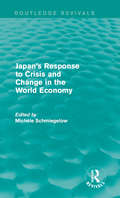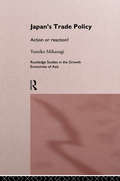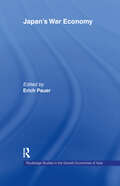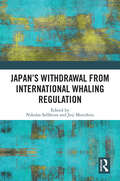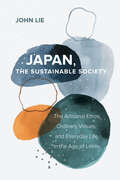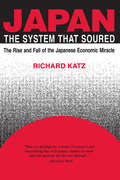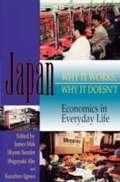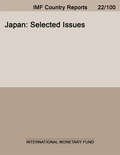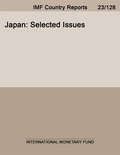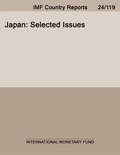- Table View
- List View
Japan's Lost Decade
by Jonathan D. Ostry Tim CallenFor thirteen years excess capacity and debt have weighed down the Japanese economy. This weak economic performance has implications for the world economy as a whole and so the IMF has been involved in a dialogue with the Japanese authorities to identify the policies needed to bring it out of its slump. The papers in this book are part of the process of identifying the causes and proposing solutions. They examine the weakness of the financial sector; corporate restructuring and structural reforms; fiscal policy; monetary and exchange rate policy and the impact of Japanese economic policies on the rest of Asia. The overall conclusion is that although a start has been made on necessary reforms, much still needs to be done
Japan's Missing Arrow?
by Laura Alfaro Hilary WhiteIn late December 2014, Shinzo Abe was elected to another term as the prime minister of Japan. His re-election was largely interpreted as a vote of confidence for his economics policies, collectively referred to as "Abenomics." Comprised of three "arrows," including expansionary monetary policy, fiscal stimulus, and structural reform, these strategies were designed to reverse Japan's two-decade long challenge with deflation and sluggish growth. Japan also faced several worrisome structural issues, including a demographic crisis, strict labor regulations, and low wage growth, despite low unemployment, in addition to a debt balance that reached 240% of GDP. As the Abe government launched a second round of quantitative easing, totaling 80 trillion per year, many wondered, would Abe's three arrows be enough to reverse Japan's problems with economic growth, rising debt, and persistent deflation?
Japan's New Imperialism (Japan In The Modern World Ser.)
by Rob StevenA full scale examination of the 1979 Sino-Vietnamese War - the events that led to it, the Cold War aftermath, and the implications for the region and beyond.
Japan's New Regional Reality: Geoeconomic Strategy in the Asia-Pacific (Contemporary Asia in the World)
by Saori N. KatadaSince the mid-1990s, Japan’s regional economic strategy has transformed. Once characterized by bilateralism, informality, and neomercantilism, Japanese policy has shifted to a new liberal strategy emphasizing regional institution building and rule setting. As two major global powers, China and the United States, wrestle over economic advantages, Japan currently occupies a pivotal position capable of tipping the geoeconomic balance in the region.Japan’s New Regional Reality offers a comprehensive analysis of Japan’s geoeconomic strategy that reveals the country’s role in shaping regional economic order in the Asia-Pacific. Saori N. Katada explains Japanese foreign economic policy in light of both international and domestic dynamics. She points out the hurdles to implementing a state-led liberal strategy, detailing how domestic political and institutional changes have been much slower and stickier than the changing regional economics. Katada highlights state-market relations and shows how big businesses have responded to the country’s interventionist policies. The book covers a wide range of economic issues including trade, investment, finance, currency, and foreign aid. Japan’s New Regional Reality is a meticulously researched study of the dynamics that have contributed to economic and political realities in the Asia-Pacific today, with significant implications for future regional trends.
Japan's Postwar History
by Gary D. AllinsonJapan's Postwar History presents the first integrated analysis of the social, economic, and political changes that Japan has experienced since 1945. Drawing on more than three decades of first-hand experience with the country, Gary D. Allinson depicts a dynamic, often turbulent history and illuminates its impact on individuals, families, and communities. Between 1932 and 1952, war, devastation, and foreign occupation caused significant changes in Japan. However, the society that emerged during the 1950s still resembled its prewar predecessor in many ways, according to Allinson. Thereafter, by exploiting a fortunate combination of domestic and international conditions the Japanese people ushered in twenty years of extensive development. Growth created problems as well as profits and imposed some wrenching adjustments after the world economic crises of 1973 and 1979. Nonetheless, Japanese society steadily assimilated the benefits of affluence, Allinson argues. Until worldwide recession drew Japan into a severe economic downturn in the late 1980s, it continued to adapt to the social and political demands of a rich nation enmeshed in a global economy. By the mid-1990s, Japan had reached the end of a cycle of historical change. Plagued with uncertainty and striving to find a formula for regeneration, Japan once again found itself confronting the dilemmas of inequality, instability, and insecurity.
Japan's Quiet Transformation: Social Change and Civil Society in 21st Century Japan (Asia's Transformations)
by Jeff KingstonThe 1990s have been termed as 'Japan's lost decade' to describe how the phenomenal growth in the Japanese economy ground to a halt and the country was crippled by enormous and ongoing political, economic and social problems. In responding to these unprecedented difficulties, wide-ranging reforms have been adopted including NPO, information disclosure and judicial reform legislation. Controversially, this book argues that such reforms are creating a more robust civil society and demonstrate that Japan is far more dynamic than is generally recognized.
Japan's Response to Crisis and Change in the World Economy (Routledge Revivals)
by Michèle SchmiegelowOriginally published in 1986, after a period of global changes and financial crisis in the majority of industrialised countries, this book explores how Japan’s economy seemed to maintain its success. This study provides an overview of the Japanese case and the main schools of thought that arose from it by dealing with export-related issues such as reforms in foreign exchange and trade control laws and the internationalisation of Japan’s financial markets as well as more domestic issues such as employment and wages. This title will be of interest to students of Asian Studies and Economics.
Japan's Trade Policy: Action or Reaction? (Routledge Studies in the Growth Economies of Asia #Vol. 4)
by Yumiko MikanagiThis book explores the process of policy-making in Japan providing a valuable insight for academics and policy-makers into Japan's massive trade surpluses and the resultant mounting international pressure to resolve the situation.
Japan's War Economy (Routledge Studies in the Growth Economies of Asia #Vol. 21)
by Erich PauerThis book explores the substantial and dynamic innovations of the wartime era, identifying this period as the most influential for Japan's post-war economic structure. Erich Pauer and a team of leading Japanese and German scholars discuss important aspects of the Japanese wartime economy, including:* ideological background* the Japanese 'planned economy'* technical mobilization* women and the war economy* socio-economic change* food shortages, the black market and economic crime* national policy companies* financial reforms
Japan's Withdrawal from International Whaling Regulation
by Nikolas Sellheim Joji MorishitaThis book examines the impact and implications of Japan's withdrawal from the International Convention for the Regulation of Whaling (ICRW), which came into effect in July 2019. In 1982 the International Whaling Commission (IWC) adopted a moratorium on commercial whaling which has been in effect ever since, despite the resistance of some countries, first and foremost Japan, Norway and Iceland, that engage in commercial whaling. As one of the key contributors to scientific research and funding, Japan's withdrawal has the potential to have wide-ranging implications and this volume examines the impact of Japan's withdrawal on the IWC itself, on the governance of whaling, and on indigenous and coastal whaling. It provides backgrounds and commentaries on this decision as well as normative and legal discussions on matters relating to sustainable use of resources, and philosophies surrounding whaling in different IWC countries. The consideration of other international environmental regimes, such as the Convention on International Trade in Endangered Species (CITES) are also examined in order to determine the international ripple effect of Japan’s decision. The book reveals that this is not just a matter of whaling but one which has significant legal, managerial and cultural implications. Drawing on deep analyses of IWC structures, the book addresses core philosophies underlying the whaling debate and in how far these may influence environmental governance in the future. This book will be of great interest to students and scholars of environmental law and governance, biodiversity conservation and sustainable development, as well as policymakers involved in international environmental and conservation agreements.
Japan's Withdrawal from International Whaling Regulation (Routledge Studies in Conservation and the Environment)
by Nikolas Sellheim Joji MorishitaThis book examines the impact and implications of Japan’s withdrawal from the International Convention for the Regulation of Whaling (ICRW), which came into effect in July 2019. In 1982 the International Whaling Commission (IWC) adopted a moratorium on commercial whaling which has been in effect ever since, despite the resistance of some countries, first and foremost Japan, Norway and Iceland, that engage in commercial whaling. As one of the key contributors to scientific research and funding, Japan’s withdrawal has the potential to have wide-ranging implications and this volume examines the impact of Japan’s withdrawal on the IWC itself, on the governance of whaling, and on indigenous and coastal whaling. It provides backgrounds and commentaries on this decision as well as normative and legal discussions on matters relating to sustainable use of resources, and philosophies surrounding whaling in different IWC countries. The consideration of other international environmental regimes, such as the Convention on International Trade in Endangered Species of Wild Fauna and Flora (CITES), is also examined in order to determine the international ripple effect of Japan’s decision. The book reveals that this is not just a matter of whaling but one which has significant legal, managerial and cultural implications. Drawing on deep analyses of IWC structures, the book addresses core philosophies underlying the whaling debate and in how far these may influence environmental governance in the future. This book will be of great interest to students and scholars of environmental law and governance, biodiversity conservation and sustainable development, as well as policymakers involved in international environmental and conservation agreements.
Japan, the Sustainable Society: The Artisanal Ethos, Ordinary Virtues, and Everyday Life in the Age of Limits
by John LieBy the late twentieth century, Japan had gained worldwide attention as an economic powerhouse. Having miraculously risen from the ashes of World War II, it was seen by many as a country to be admired if not emulated. But by the early 1990s, that bubble burst in spectacular fashion. The Japanese economic miracle was over. In this book, John Lie argues that in many ways the Japan of today has the potential to be even more significant than it was four decades ago. As countries face the prospect of a world with decreasing economic growth and increasing environmental dangers, Japan offers a unique glimpse into what a viable future might look like—one in which people acknowledge the limits of the economy and environment while championing meaningful and sustainable ways of working and living. Beneath and beyond the rhetoric of growth, some Japanese are leading sustainable lives and creating a sustainable society. Though he does not prescribe a one-size-fits-all cure for the world, Lie makes the compelling case that contemporary Japanese society offers a possibility for how other nations might begin to valorize everyday life and cultivate ordinary virtues.
Japan, the System That Soured: The Rise And Fall Of The Japanese Economic Miracle
by Richard KatzAfter seven long years of economic malaise, it is clear that something has gone awry in Japan. Unless Japan undertakes sweeping reform, official forecasts now warn, growth will steadily dwindle. How could the world's most acclaimed economic miracle have stumbled so badly? As this important book explains, the root of the problem is that Japan is still mired in the structures, policies, and mental habits of the 1950s-1960s. Four decades ago while in the "catch-up" phase of its economic evolution, policies that gave rise to "Japan, Inc". made a lot of sense. By the 1970s and 1980s, when Japan had become a more mature economy, "catch-up economics" had become passe, even counterproductive. Even worse, in response to the oil shocks, Japan increasingly used its industrial policy tools. not to promote "winners", but to shield "losers" from competition at home and abroad. Japan's well-known aversion to imports is part and parcel of this politically understandable, but economically self-defeating, pattern. The end result is a deformed "dual economy" unique in the industrial world. Now this "dualism" is sapping the strength of the entire economy. The protection of the weak is driving Japan's most inefficient companies to invest offshore instead of at home. Without sweeping reform, real recovery will prove elusive. The challenging thesis articulated in this book is receiving widespread media attention in the United States and Japan and is sure to provoke continuing debate and controversy.
Japan: Betting on Inflation?
by Julio J. RotembergThe case focuses on the challenges still confronting Prime Minister Shinzo Abe at the end of 2013, a year after he has been in office. It also gives an overview of Japan's earlier economic performance, focusing primarily on the period after it suffered a stock market and real estate crash in 1989-1992. During his first year in office, Abe introduced three sets of policies designed both to reverse the deflation that had plagued Japan since around 2000 and to increase the Japanese growth rate. The first of this three-pronged approach consisted of appointing a central bank governor who committed himself to raising the inflation rate and who vastly expanded the Bank of Japan's balance sheet in an effort to accomplish this. The second involved a fiscal policy plan whose initial thrust was expansionary, but which also sought to reduce future budget deficits. The last one involved a series of microeconomic reforms aimed at expanding GDP and labor productivity. These included initiatives aimed at increasing female labor force participation to compensate for Japan's aging population, reforms of the electric power sector directed at reducing electricity costs, and efforts designed to promote the "health and longevity sector." The case ends by discussing Abe's foreign policy challenges, including Korea's and China's reactions to visits by Japanese officials to the Yasukuni shrine.
Japan: Betting on Inflation?
by Julio J. RotembergThe case focuses on the challenges still confronting Prime Minister Shinzo Abe at the end of 2013, a year after he has been in office. It also gives an overview of Japan's earlier economic performance, focusing primarily on the period after it suffered a stock market and real estate crash in 1989-1992. During his first year in office, Abe introduced three sets of policies designed both to reverse the deflation that had plagued Japan since around 2000 and to increase the Japanese growth rate. The first of this three-pronged approach consisted of appointing a central bank governor who committed himself to raising the inflation rate and who vastly expanded the Bank of Japan's balance sheet in an effort to accomplish this. The second involved a fiscal policy plan whose initial thrust was expansionary, but which also sought to reduce future budget deficits. The last one involved a series of microeconomic reforms aimed at expanding GDP and labor productivity. These included initiatives aimed at increasing female labor force participation to compensate for Japan's aging population, reforms of the electric power sector directed at reducing electricity costs, and efforts designed to promote the "health and longevity sector." The case ends by discussing Abe's foreign policy challenges, including Korea's and China's reactions to visits by Japanese officials to the Yasukuni shrine.
Japan: Beyond the Bubble
by Richard H.K. Vietor Rebecca EvansBy the summer of 2001, Japan's economy had been generally stagnant for nearly 10 years--since the collapse of the bubble economy in 1990-91. The development strategy that drove the nation during earlier decades was fulfilled, and by 1989 Japan's GDP per capita exceeded that of the United States. Facing another downturn, Prime Minister Koizumi seemed ready politically to undertake real change. A rewritten version of an earlier case.
Japan: Deficits, Demography, and Deflation
by Richard H.K. VietorBy 2005, Japan's debt had risen to 163% of GDP. For more than a decade, the government had run huge deficits, trying unsuccessfully to stimulate economic growth. Interest rates, meanwhile, had been zero for years. But with slow growth and banks in crisis, nothing had worked very well until some recovery in 2004. Now, the government is trying to repair its fiscal damage in the face of continuing slow growth and huge pension and health care obligations to a population that is aging fast. Hezio Takenaka, the minister for economy and postal privatization, faces a imposing agenda--to restart the economy while lowering the deficits and reforming social security.
Japan: Economics in Everyday Life
by James Mak Shigeyuki Abe Kazuhiro Igawa Shyam SunderAll you could possibly want to know about the Japanese and Japanese economy.
Japan: Selected Issues
by J. Morsink R. Ramaswamy M. Mütleisen T. Nagaoka H. Samiei H. FaruqeeThis report on Selected Issues was prepared by staff from the International Monetary Fund as background documentation for the periodic consultation with Japan. Papers discuss: population ageing and its macroeconomic implications; sustainable fiscal policies for an ageing population; the yen-dollar rate; deposit insurance reform; the unemployment deflation puzzle.
Japan: Selected Issues
by International Monetary FundA report from the International Monetary Fund.
Japan: Selected Issues (Imf Staff Country Reports)
by International Monetary Fund. Asia and Pacific DeptA report from the International Monetary Fund.
Japan: Selected Issues (Imf Staff Country Reports)
by International Monetary Fund. Asia and Pacific DeptA report from the International Monetary Fund.
Japan: Selected Issues (Imf Staff Country Reports)
by International Monetary Fund. Asia and Pacific DeptA report from the International Monetary Fund.
